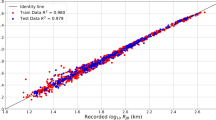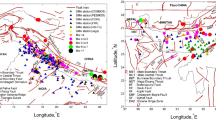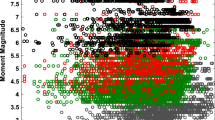Abstract
We have used the Artificial Neural Network method (ANN) for the derivation of physically sound, easy-to-handle, predictive ground-motion models from a subset of the Reference database for Seismic ground-motion prediction in Europe (RESORCE). Only shallow earthquakes (depth smaller than 25 km) and recordings corresponding to stations with measured \(V_{s30}\) properties have been selected. Five input parameters were selected: the moment magnitude \(M_{W}\), the Joyner–Boore distance \(R_{JB}\), the focal mechanism, the hypocentral depth, and the site proxy \(V_{S30}\). A feed-forward ANN type is used, with one 5-neuron hidden layer, and an output layer grouping all the considered ground motion parameters, i.e., peak ground acceleration (PGA), peak ground velocity (PGV) and 5 %-damped pseudo-spectral acceleration (PSA) at 62 periods from 0.01 to 4 s. A procedure similar to the random-effects approach was developed to provide between and within event standard deviations. The total standard deviation (\(\sigma \)) varies between 0.298 and 0.378 (log\(_{10}\) unit) depending on the period, with between-event and within-event variabilities in the range 0.149–0.190 and 0.258–0.327, respectively. Those values prove comparable to those of conventional GMPEs. Despite the absence of any a priori assumption on the functional dependence, our results exhibit a number of physically sound features: magnitude scaling of the distance dependency, near-fault saturation distance increasing with magnitude, amplification on soft soils and even indications for nonlinear effects in softer soils.











Similar content being viewed by others
References
Abrahamson NA, Youngs RR (1992) A stable algorithm for regression analyses using the random-effects model. Bull Seismol Soc Am 82:505–510
Akkar S, Bommer JJ (2010) Empirical equations for the prediction of PGA, PGV and spectral accelerations in Europe, the Mediterranean region and the Middle East. Seismol Res Lett 81:195–206
Akkar S, Çagnan Z (2010) A local ground-motion predictive model for Turkey and its comparison with other regional and global ground-motion models. Bull Seismol Soc Am 100:2978–2995
Akkar S, Sandıkkaya MA, Şenyurt M, Azari AS, Ay BÖ (2013) Reference database for seismic ground-motion in Europe (RESORCE), Bull Earthq Eng, submitted to this issue
Al Atik L, Abrahamson N, Bommer JJ, Scherbaum F, Cotton F, Kuehn N (2010) The variability of ground-motion prediction models and its components. Seismol Res Lett 81:794–801
Alavi AH, Gandomi AH (2011) Prediction of principal ground-motion parameters using a hybrid method coupling artificial neural networks and simulated annealing. Comput Struct 89:2176–2194
Anderson JG (2000) Expected shape of regressions for ground-motion parameters on rock. Bull Seismol Soc Am 90:S43–S52
Assimaki D, Li W (2008) Site amplification and attenuation via downhole array seismogram inversion: a comparative study of the 2003 Miyagi-Oki, aftershock sequence. Bull Seism Soc Am 98:301–330
Bindi D, Pacor F, Luzi L, Puglia R, Massa M, Ameri G, Paolucci R (2011) Ground motion prediction equations derived from the Italian strong motion database. Bull Earthq Eng 9:1899–1920
Bommer JJ, Douglas J, Scherbaum F, Cotton F, Bungum H, Fäh D (2010) On the selection of ground-motion prediction equations for seismic hazard analysis. Seismol Res Lett 81:783–793
Cadet H, Bard PY, Duval AM, Bertrand E (2012) Site effect assessment using KiK-net data—part 2—site amplification prediction equation (SAPE) based on \(f_{0}\) and \(V_{sz}\). Bull Earthq Eng 10:451–489. doi: 10.1007/s10518-011-9298-7
Castellaro S, Mulargia F, Rossi PM (2008) \(V_{s30}\): proxy for seismic amplification? Seism Res Lett 79:540–543
Demuth H, Beale M, Hagan M (2009) Neural Network Toolbox\(^{{\rm Tm}}\) 6.User’s Guide. The MathWorks, Inc.
Derras B, Bekkouche A, Zendagui D (2010) Neuronal approach and the use of kik-net network to generate response spectrum on the surface. Jordan J Civ Eng 4:12–21
Derras B, Bard PY, Cotton F, Bekkouche A (2012) Adapting the neural network approach to PGA prediction: an example based on the KiK-net data. Bull Seism Soc Am 102:1446–1461 http://www.bssaonline.org/content/102/4/1446.abstract
Douglas J, Jousset P (2011) Modeling the difference in ground-motion magnitude-scaling in small and large earthquakes. Seismol Res Lett 82:504–508
García SR, Romo MP, Mayoral JM (2007) Estimation of peak ground accelerations for Mexican subduction zone earthquakes using neural networks. Geofísica Int 46:51–63
Hu YH, Hwang JN (2002) Handbook of neural network signal processing. Acoust Soc Am 111:2525–2526
Irshad A, El Naggar H, Khan AN (2008) Neural networks based attenuation of strong motion peaks in Europe. J Earthq Eng 12:663–680
Kerh T, Ting SB (2005) Neural network estimation of ground peak acceleration at stations along Taiwan high-speed rail system. Eng Appl Artif Intell 18:857–866
Kokusho T, Sato K (2008) Surface-to-base amplification evaluated from KiK-net vertical array strong motion records. Soil Dyn Earthq Eng 28:707–716
Lee VW, Trifunac MD (2010) Should average shear-wave velocity in the top 30m of soil be used to describe seismic amplification. Soil Dyn Earthq Eng 30:1250–1258
Liu B-Y, Ye LY, Xiao ML, Miao S (2006) Peak ground velocity evaluation by artificial neural network for West America region. In: 13th international conference on neural information processing 4234:942–951
Mucciarelli M, Gallipoli MR (2006) Comparison between \(V_{s30}\) and other estimates of site amplification in Italy. In: Proceedings 1st European conference on earthquake engineering and seismology, Cd-Rom edition, paper 270
Peter A, Harald B, Wolfgang M (2008) A learning rule for very simple universal approximators consisting of a single layer of perceptrons. Neural Netw 21:786–795
Robitaille B, Marcos B, Veillette M, Payr G (1996) Modified quasi-Newton methods for training neural networks. Comput Chem Eng 20:1133–1140
Sandıkkaya MA, Akkar S, Bard PY (2013) A nonlinear site amplification model for the next pan European ground motion prediction equations. Bull Seism Soc Am, February 2013, 103:19–32, doi:10.1785/0120120008
Wolfgang M (1997) Networks of spiking neurons: the third generation of neural network models. Neural Netw 10:1659–1671
Acknowledgments
The authors thank S. Akkar, J. Douglas and A. Laurendeau for their generous help with computer codes of the random-effect procedure. We acknowledge the support from the Tassili program: 13MDU901 (Prédiction du mouvement sismique et estimation du risque sismique lié aux effets de site) and from the SIGMA (Seismic Ground Motion assessment) project. We also want to emphasize the background work of all strong motion network operators, without whom GMPEs and Hazard assessment studies could not exist. We also thank J. Douglas (Guest Reviewer) and anonymous reviewers for their constructive criticism and comments that helped us to improve this manuscript.
Data and Resources
The RESORCE database used in this article have been collected and disseminated by the Euro-Mediterranean Seismological Centre (EMSC) data management center at http://jaguar.emsc-csem.org/sigma/
Author information
Authors and Affiliations
Corresponding author
Electronic supplementary material
Below is the link to the electronic supplementary material.
Rights and permissions
About this article
Cite this article
Derras, B., Bard, P.Y. & Cotton, F. Towards fully data driven ground-motion prediction models for Europe. Bull Earthquake Eng 12, 495–516 (2014). https://doi.org/10.1007/s10518-013-9481-0
Received:
Accepted:
Published:
Issue Date:
DOI: https://doi.org/10.1007/s10518-013-9481-0




